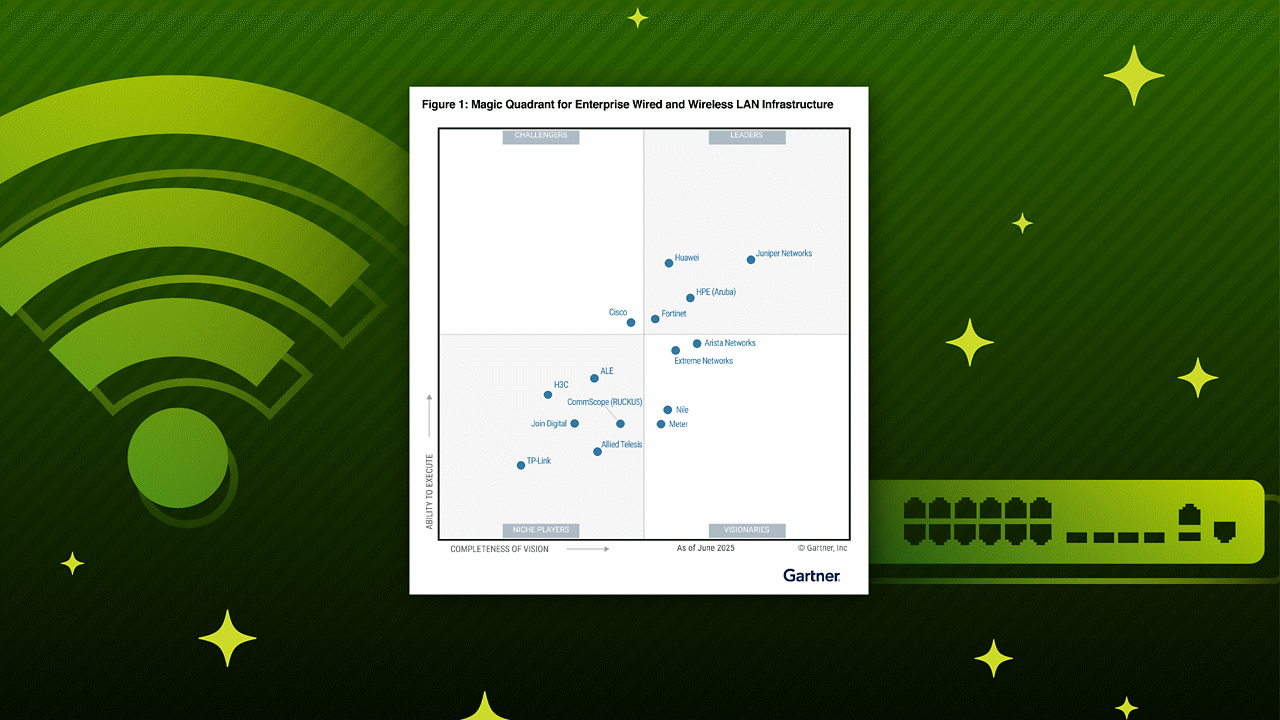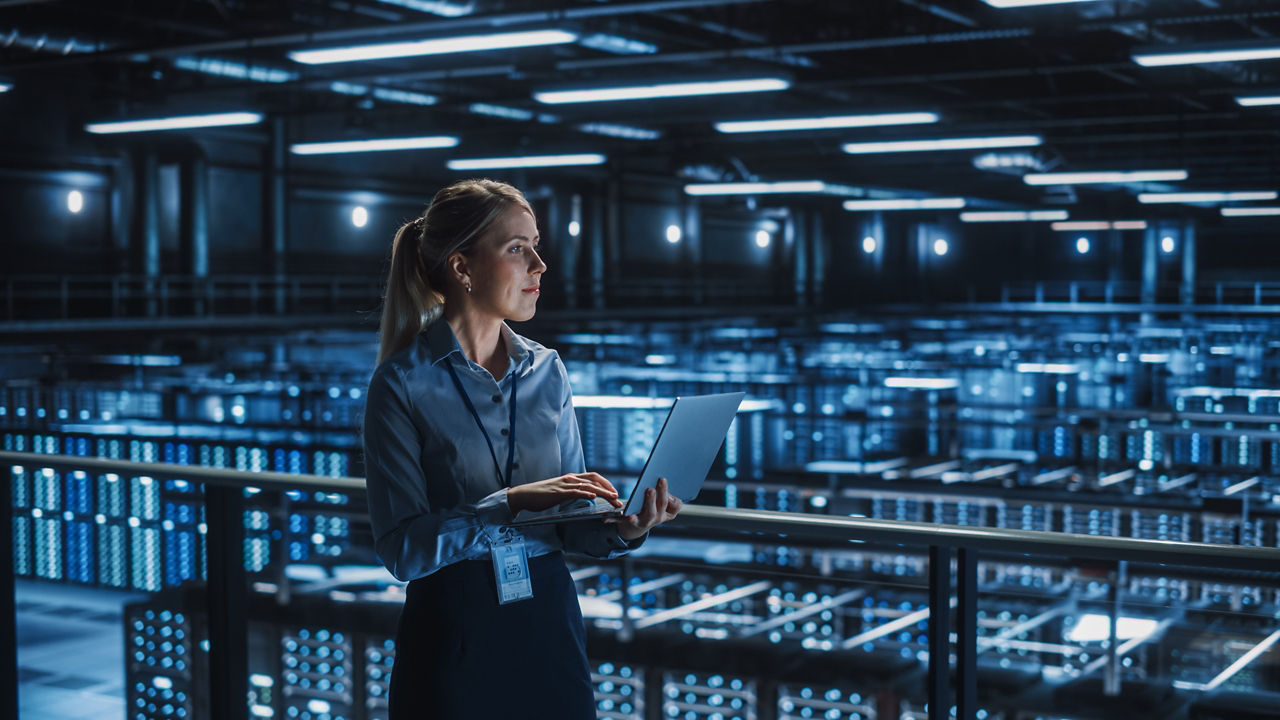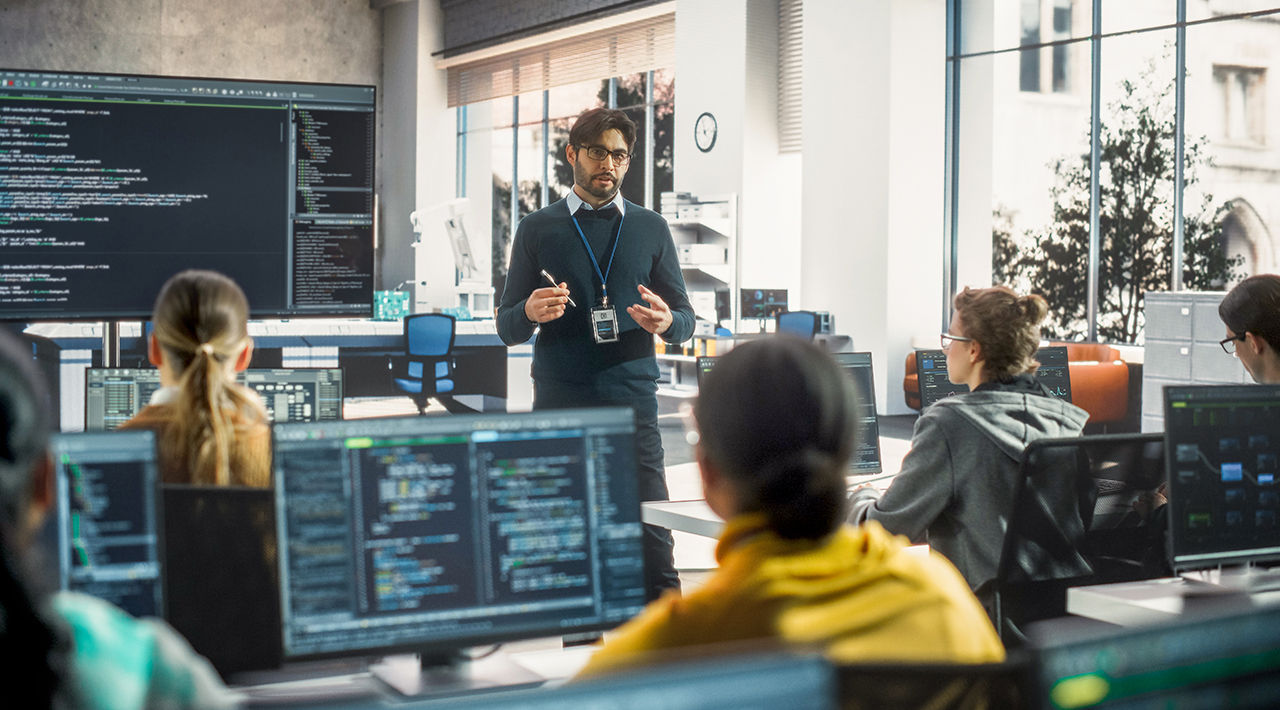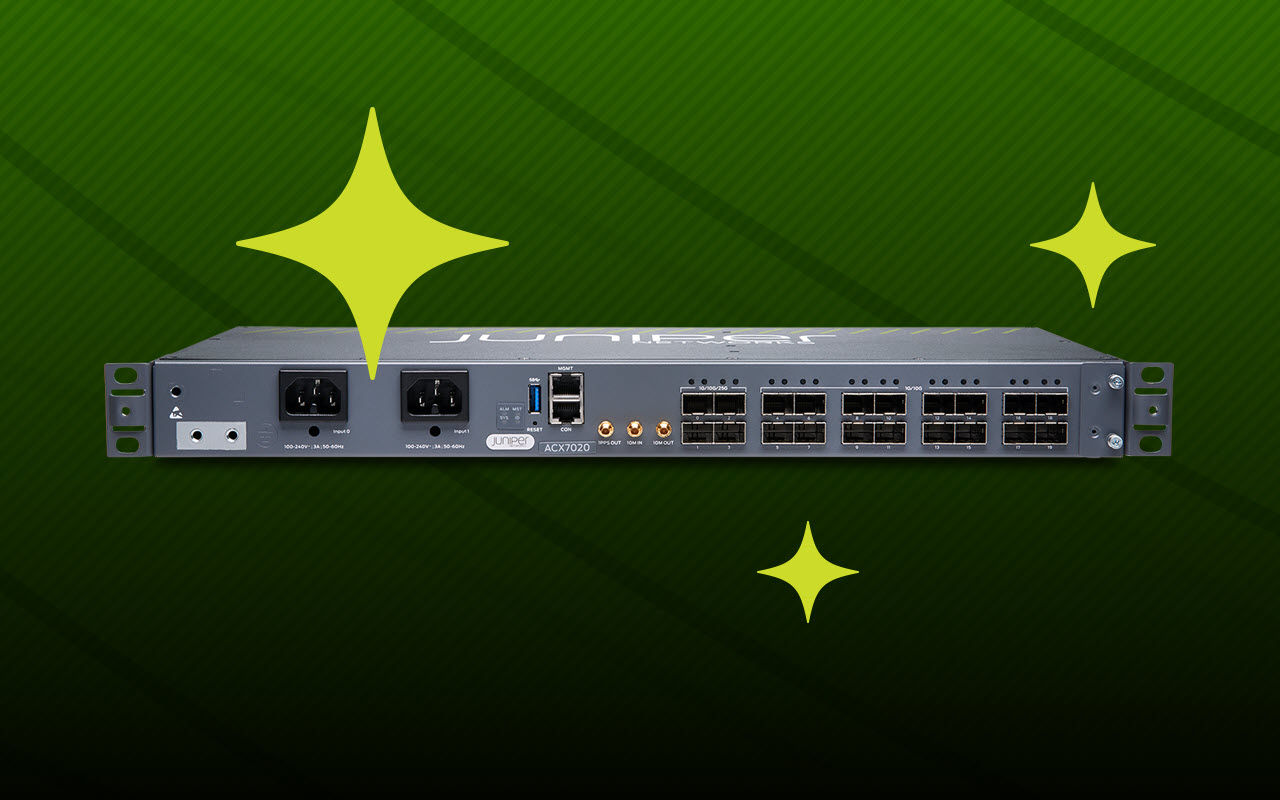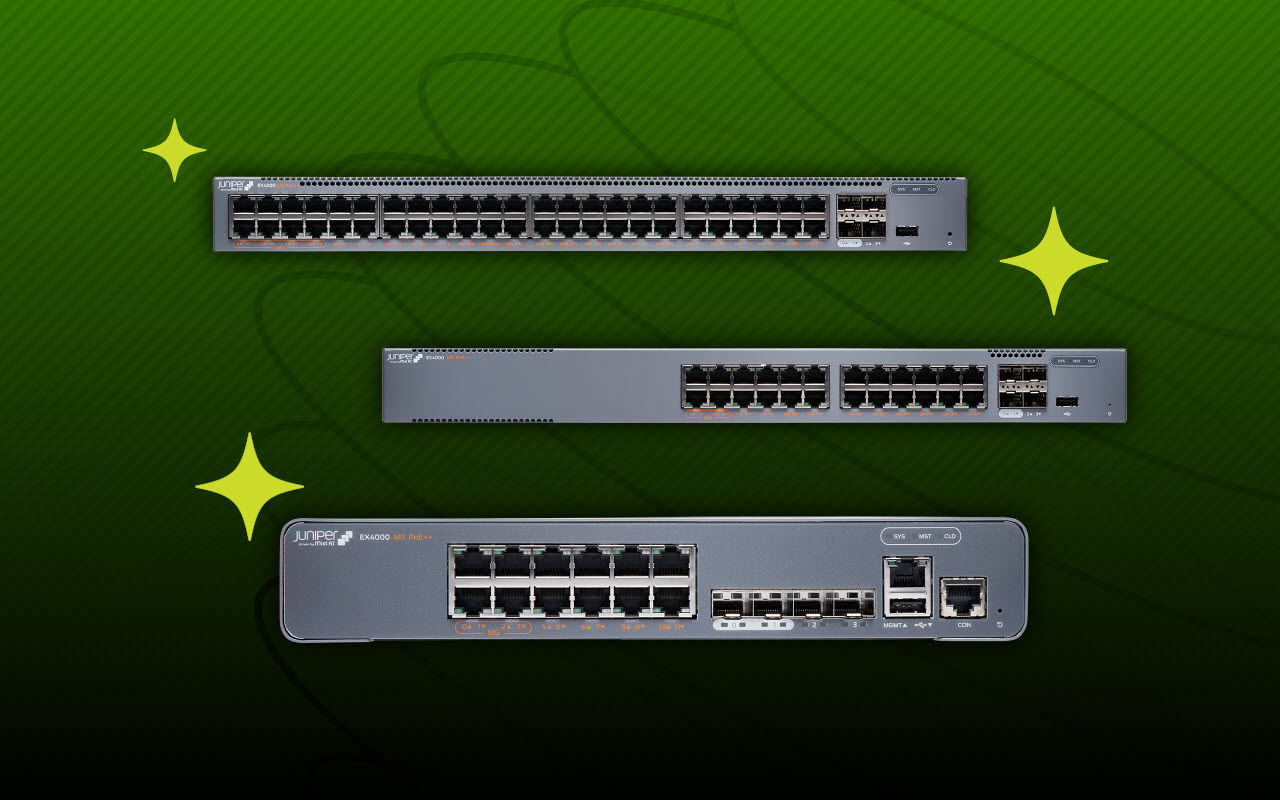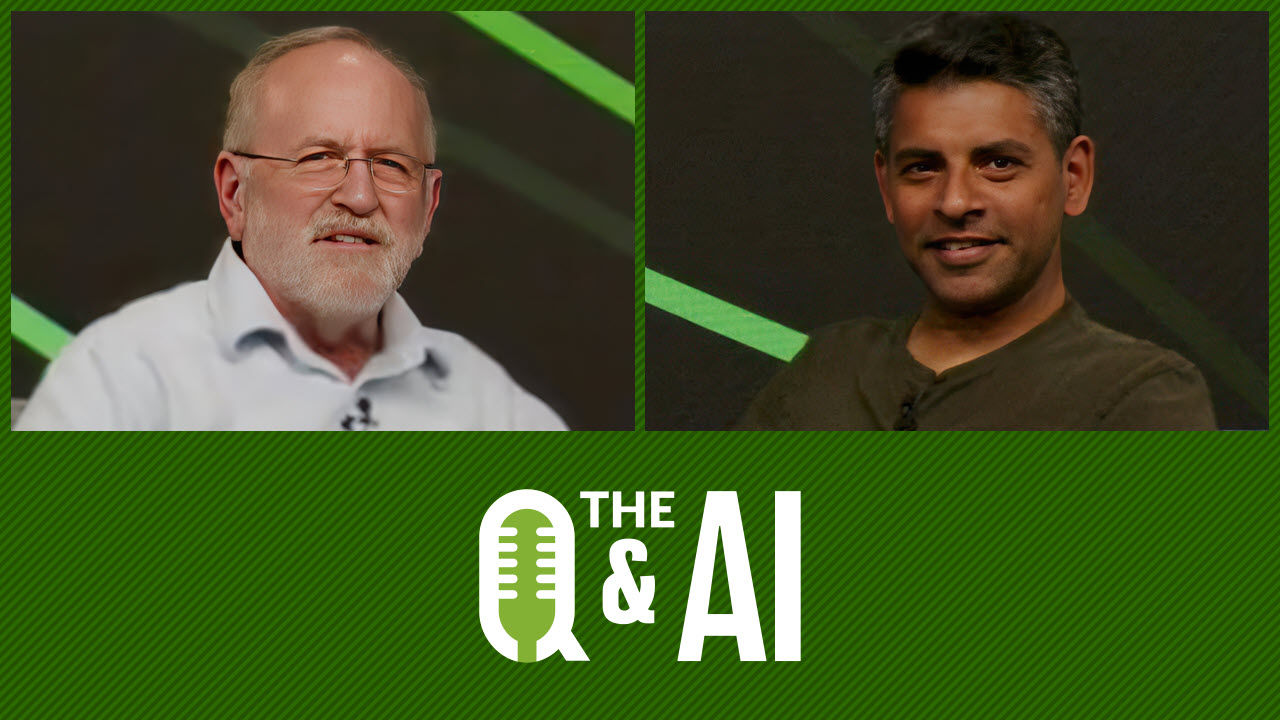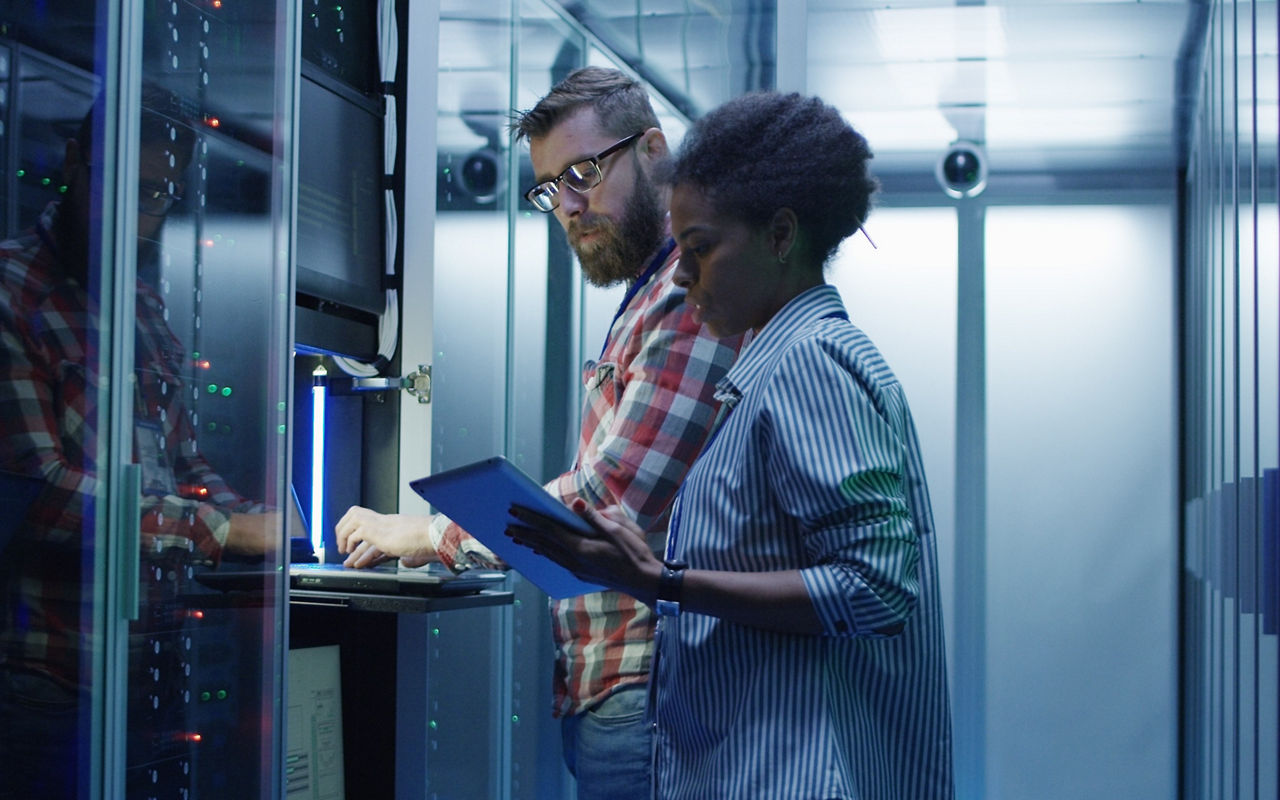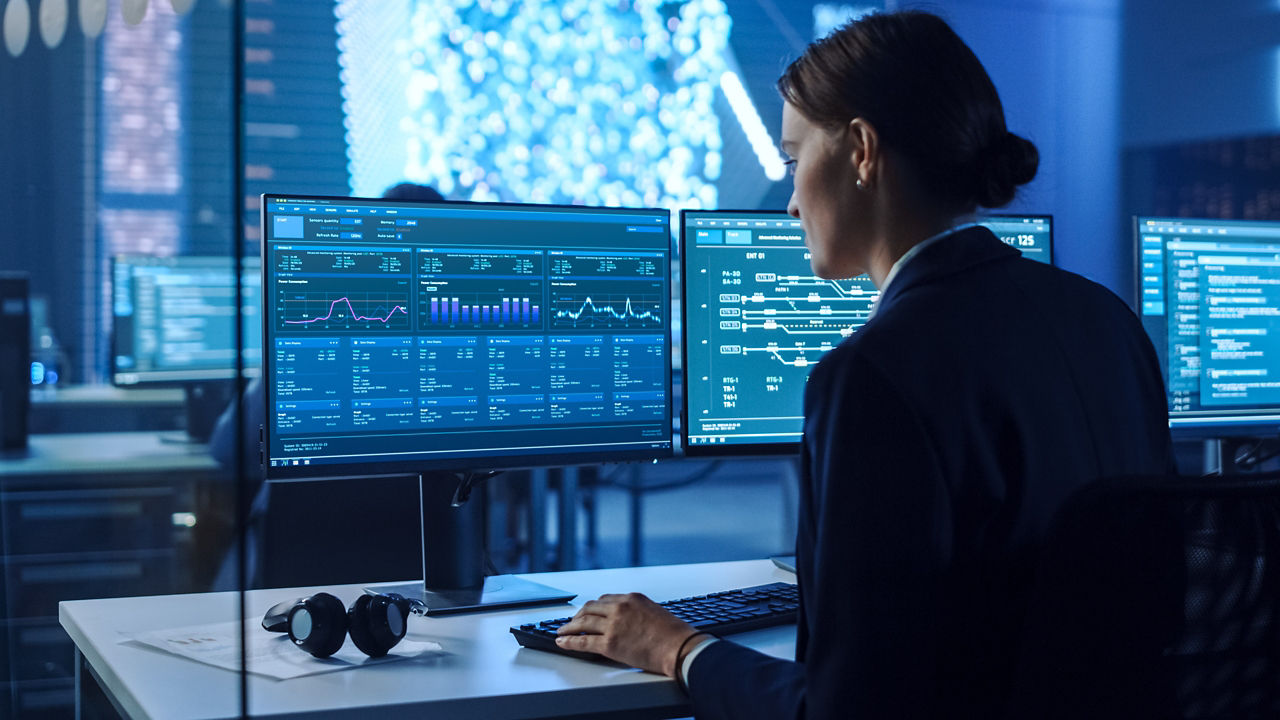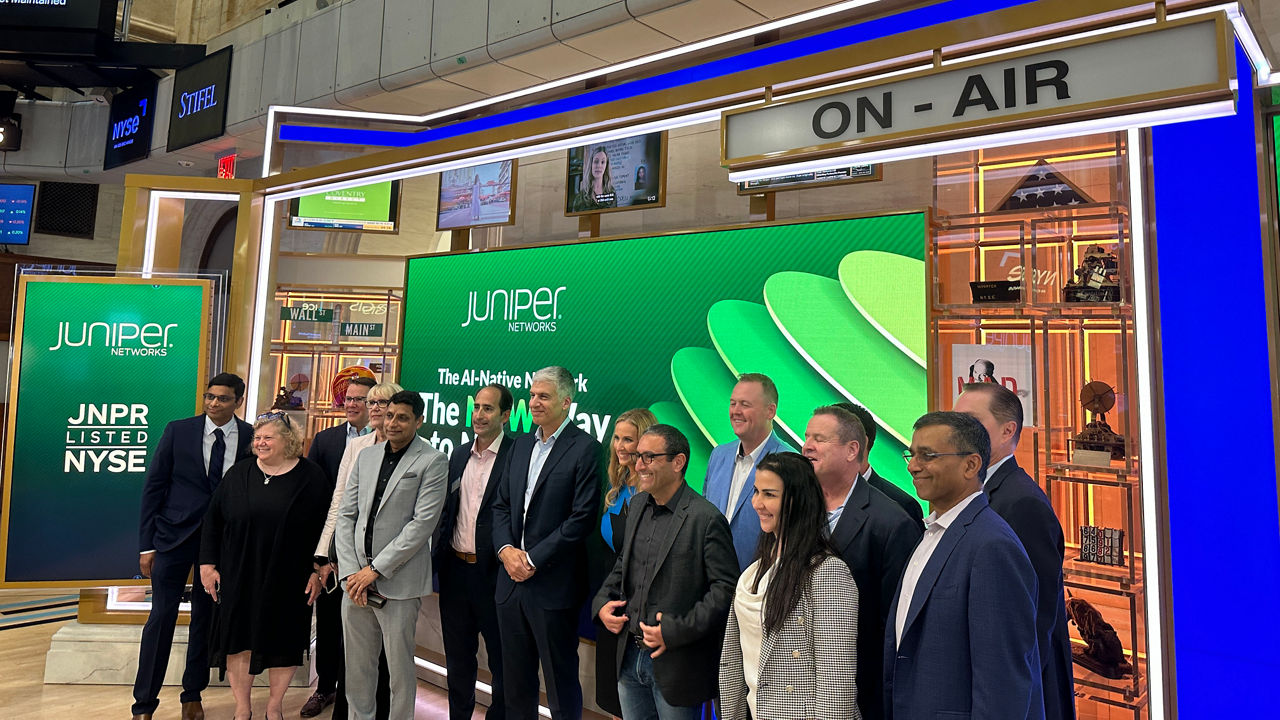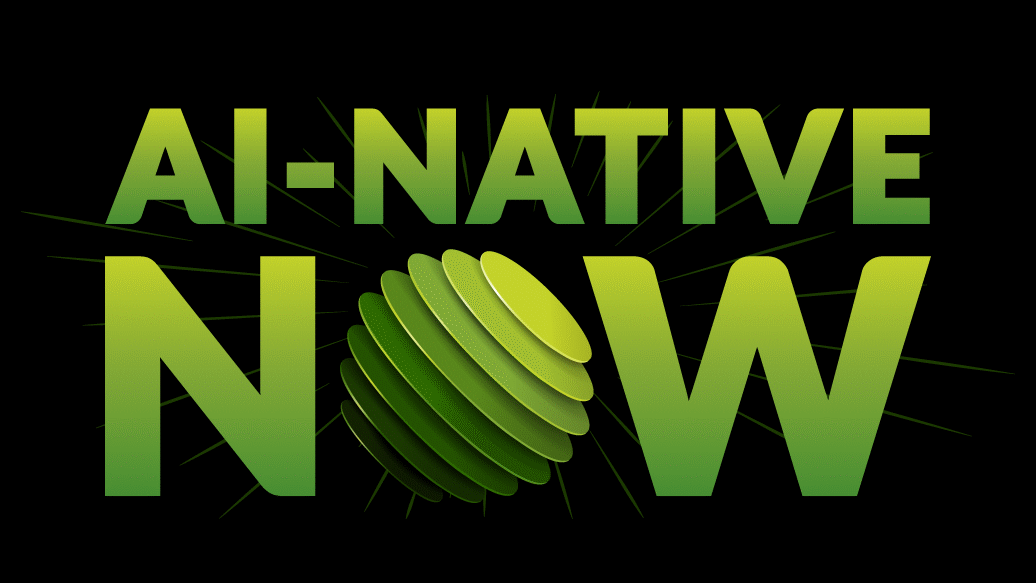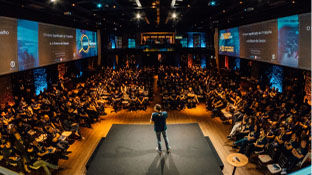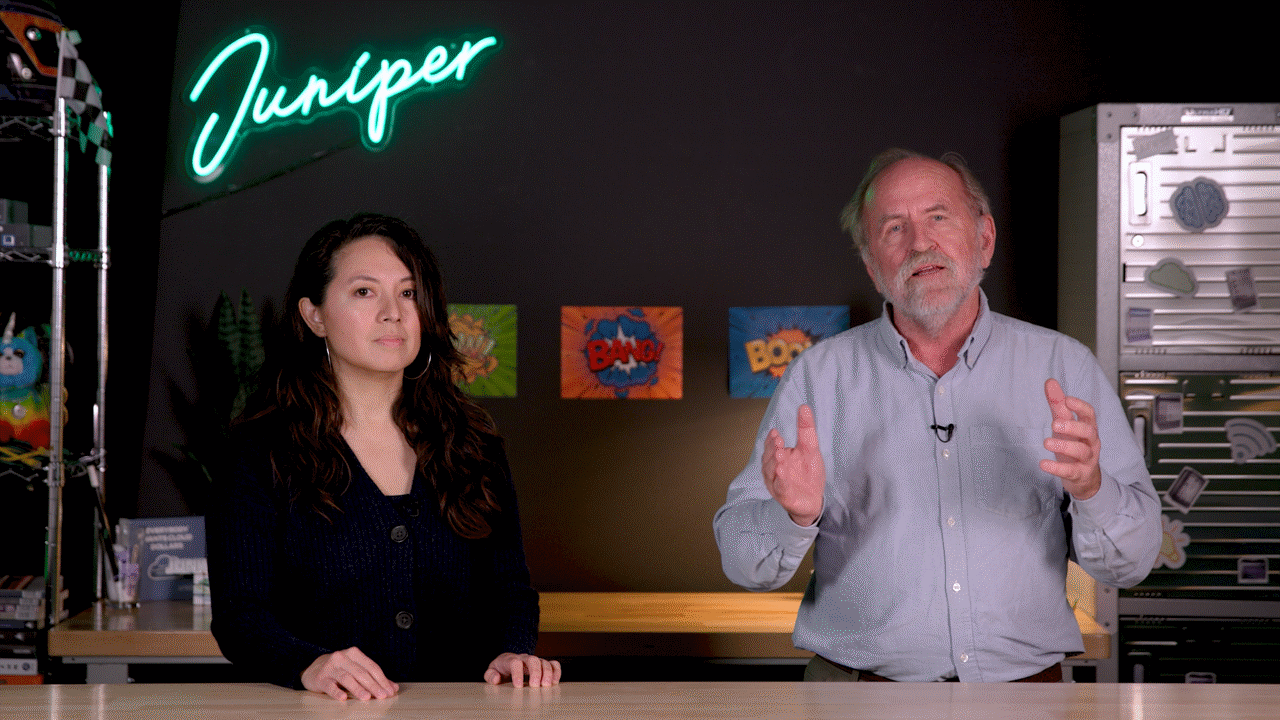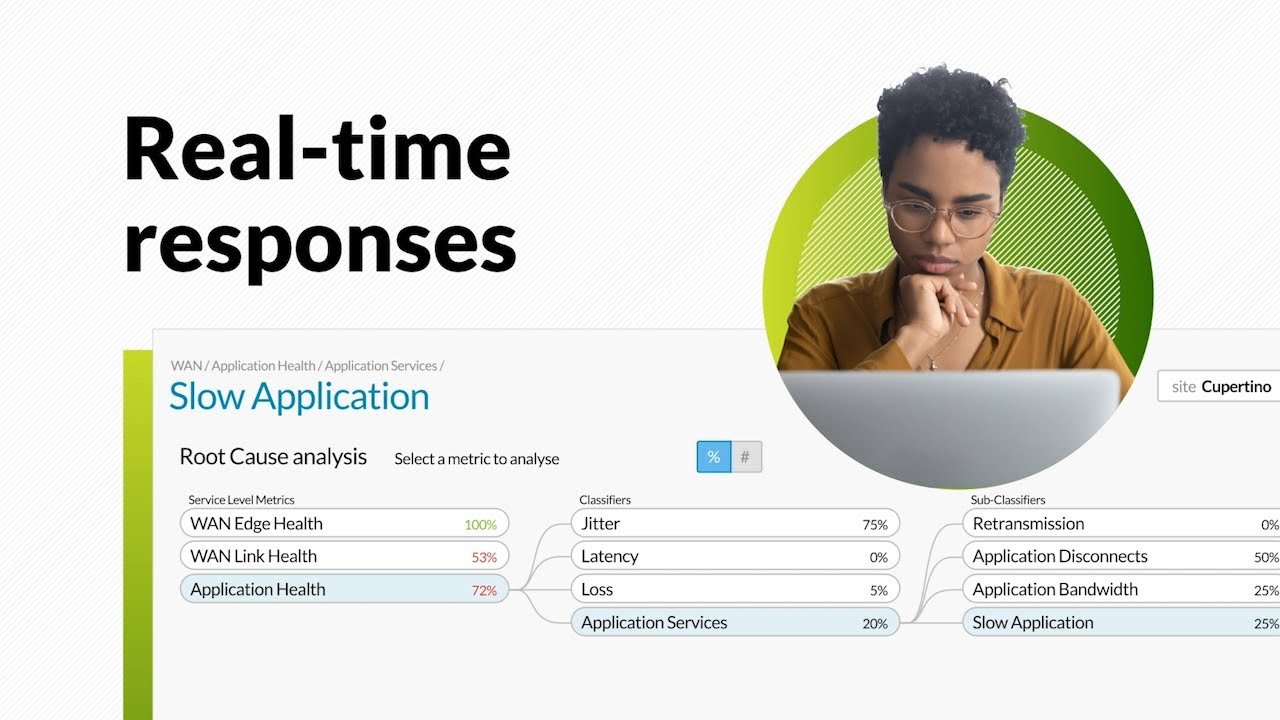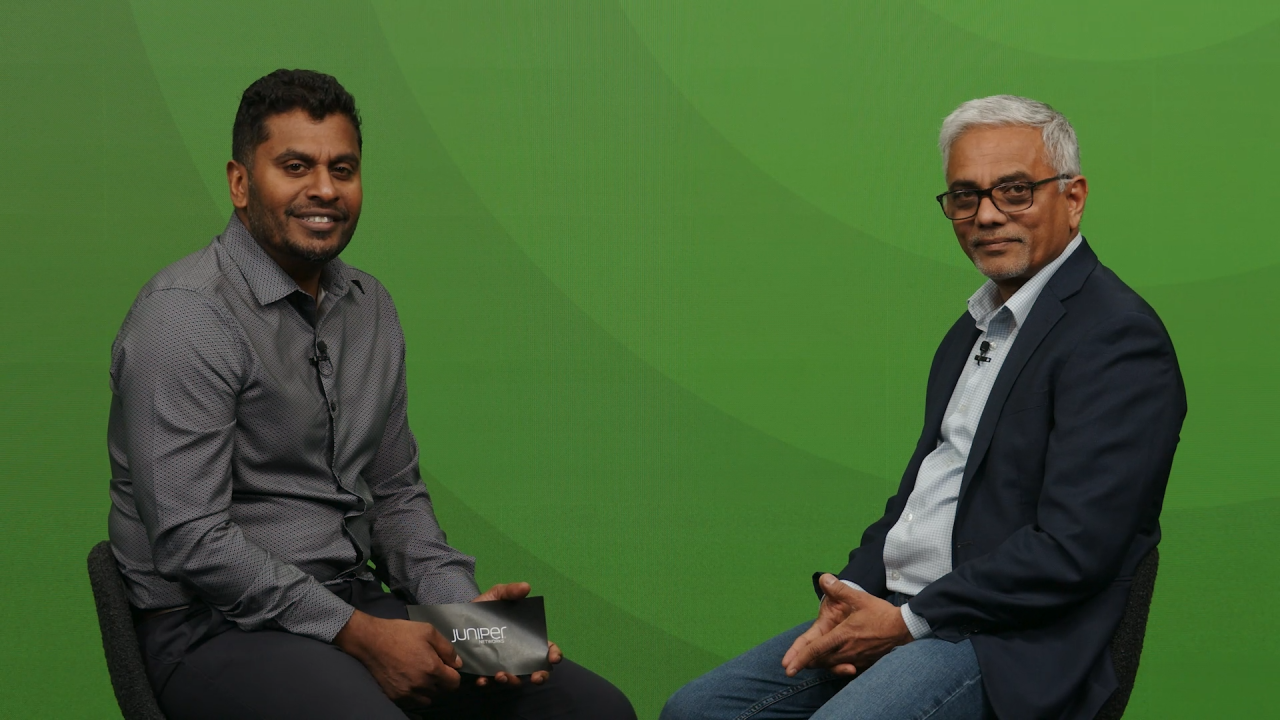Discovery, Inc. Meets a Tenfold Increase in Bandwidth Demand with its Juniper WAN | Juniper Summit


Discovery, Inc. Meets a Tenfold Increase in Bandwidth Demand with its Juniper WAN
See how Discovery, Inc. Meets a Tenfold Increase in Bandwith Demand with its Juniper WAN.
You’ll learn
Why a robust WAN infrastructure is important for handling the high demands of video broadcasting and maintaining quality.
How discovery has developed a robust, internally managed MPLS WAN using Juniper MX Series routers.
How Discovery + successful launch allowed it to attracted millions of subscribers.
Who is this for?
Host

Guest speakers

Experience More
Transcript
0:00 [music]
0:07 -Hello everyone, I'm Sharon Mandell, the CIO of Juniper Networks.
0:11 I'm delighted to be joined here today by Brian
0:13 Duvall, Vice President Network Platform at Discovery.
0:17 Brian, welcome. It' s really good to have you here today.
0:21 -Hi, Sharon. I' m very happy to be here.
0:23 -I don' t know if you know this, but I spent a good chunk
0:26 of my career in the media industry, both at media companies,
0:32 as well as building technology in vendors to deliver for it.
0:40 It's really exciting to be able to sit here with you and really see
0:44 where things have gone over the last number of years in the video space,
0:49 and what leverages the network.
0:51 -Oh, yes, the media space can be a definite challenge, so I' m sure
0:54 if you' ve had experience in it, you' re aware of what I do.
0:59 -Why don' t we get going?
Discovery Networks
1:00 Tell us what' s going on over at Discovery Networks and what your mission is?
1:05 -Discovery, like most media companies, is undertaking a lot of change.
1:10 It's a difficult mission, but overall, it' s still the same mission
1:13 of trying to deliver quality content to as many people as we can,
1:17 and as many platforms as we can.
1:20 Most people know us from our namesake channel, right?
1:22 Discovery Channel.
1:23 It's a known brand, people know that, but we have
1:26 so many great brands around the globe.
1:28 We're in 220 countries around the globe, which a lot of people don' t realize.
1:33 A lot of people think, "Oh, it's probably US only network."
1:35 Pretty much everywhere, and we have a number of great
1:38 brands beyond Discovery Channel, TLC, HGTV, Food Network,
1:43 Magnolia for those Chip and Joanna fans.
1:46 We just have so many great brands that all fall
1:49 underneath Discovery, so we're excited about that.
1:52 Our international business is really interesting that people
1:56 don' t realize we have live sports, we have news channels,
1:59 we have so much internationally across our Eurosport
2:03 brand, which is the home for the Olympics.
2:05 We've got TVN, the biggest news network in all of Poland, and we have Golf TV,
2:11 pretty much golf internationally goes through our kind of digital brands.
2:16 We're growing, we' ve acquired a lot, and that' s our big-
2:21 the big mission is just great content as many people as we can.
Juniper WAN
2:26 -Yes, it's a tremendous collection of assets for sure.
2:30 Tell me about your WAN and the role it plays at Discovery.
2:34 -Yes, the WAN at Discovery is very unique. It' s completely key to our business.
2:39 A lot of corporate enterprises, the WAN is just viewed
2:44 as this expense, I don' t want to have to invest in it,
2:46 but I need something to connect to my offices together.
2:49 At Discovery, it truly is core to our business.
2:54 We built a global MPLS network managed by our internal team.
2:58 This isn't vendor-managed, this is internally
3:00 managed MPLS across Juniper MX Series routers.
3:04 Juniper is definitely key to everything we do.
3:08 Technically, it' s a traditional MPLS, backbone, a lot of layer three VPNs,
3:12 multicast VPNs to handle all of our live video and audio services around the globe.
3:19 It's become so common and core to our business that executive
3:24 leadership at Discovery knows the term WAN and it' s brought up often.
3:28 You usually don' t see an exec getting on a conference
3:31 call and thanking and saying how great the WAN is.
3:34 At Discovery, it' s become common verbiage.
3:38 That' s ...
3:39 -That' s really amazing. Most IT leaders don' t get thanked for their WAN.
3:45 They only get called-- [crosstalk]
3:46 -No, it's very paintful to be in the back of the line.
3:48 We don' t want to be called out because usually
3:49 it's only bad and we don' t get any kudos.
3:52 Discovery, the WAN has been so key and instrumental to what we do
3:56 as a global business, to allow us to be flexible and dynamic,
4:02 It's a big key part to what we do.
Cloud
4:05 -How does cloud play in Discovery' s journey and where are you guys with that?
4:11 -Cloud, obviously, is a big term for everybody
4:13 and I think a lot of people have different definitions.
4:16 Back in 2015, maybe about six or seven years ago, we had
4:19 a pivot point in our IT organization where our digital
4:23 business at that time was already leveraging cloud services.
4:26 They were already in Amazon doing our digital web pages, and all
4:31 the public spaces you went to go see to discovery.com, things like that.
4:35 Our legacy broadcast business, delivering TV content,
4:39 corporate applications was primarily on-premise in 2015.
4:43 We were running into a few big hurdles.
4:46 We were running out of data center space, do we invest in larger,
4:49 bigger data centers to house all this new
4:51 growth we had through all these acquisitions?
4:53 I mentioned all those great brands, that takes up a lot
4:56 of data center space to produce the kind of content.
4:59 We made the call, "Do we invest in data center
5:01 or do we get out of the data center business?" as we' d like to say.
5:04 That's not core to how Discovery makes money, how great we can
5:07 build a data center, let someone else build the data center for us,
5:11 and let us focus on producing amazing content.
5:14 In 2015, went to the cloud. AWS, obviously was our big provider.
5:20 Really, we migrated that time our entire global playout business.
5:24 When you watch a TV channel of Discovery' s across all those great
5:28 brands I mentioned on TV, it' s played out of an Amazon EC2 instance.
5:34 That leverages and runs across our great Juniper Network backbone,
5:38 that MPLS network that always scaled up as part of that cloud journey.
5:41 We had to get into those colocation providers, peer
5:44 with those cloud providers, and ultimately own the edge.
5:47 We want to own as much of that network space right up to that cloud provider.
5:52 Those Juniper MX routers are the ones
5:54 that literally plug in to Amazon' s network,
5:57 and we send all of our TV channels down 24/7 across those connections.
6:03 The cloud journey drove the WAN journey.
6:06 We had to get into those colocation spaces.
6:08 Then, once that was established, all the rest
6:12 of our global connectivity folded into that new model.
6:15 We had those locations that we could land our WAN connections into
6:19 at all our corporate offices and eventually replaced our entire
6:24 global connectivity with this WAN backbone.
Global Vision
6:28 -How does the Juniper Network support the global vision?
6:34 -Ultimately, it' s the flexibility of the MX
6:38 Series platform and the MPLS protocol.
6:40 If you' re able to leverage that technology static with the VPNs
6:44 and segmentation of different types of networks across that,
6:48 we were able to collapse a lot of legacy services,
6:51 that service may be a circuit for just a broadcast use.
6:55 This was connected just to deliver this video content as one provider.
6:59 Then, my corporate network team had to deliver an MPLS, or internet circuit
7:03 into this office for general email and normal corporate business apps.
7:08 We built this backbone. Now, we have all of them running on that same architecture,
7:12 common hardware platform, but different logical routing tables.
7:17 The Juniper platform division is in the Swiss Army knife, if you will,
7:23 of the MX Series platform, we can do whatever we need at scale.
7:27 If we need to turn up another connection to another provider,
7:31 if we signed a deal with Amazon, or Apple, or YouTube, or whoever,
7:37 and we need to deliver content, it' s as simple as a cross-connect,
7:40 it' s as simple as just one extra handoff from our Juniper backbone,
7:44 and they can subscribe to the video services they require.
7:47 It' s allowed us to be more nimble, more agile, we can deliver
7:50 quicker, and our content and deal teams are very happy.
7:54 We don' t have to wait months to deliver a new service or circuit, it could
7:58 just be a cross-connect between two cages at a colocation facility.
Challenges
8:03 -Agility is the name of the game today, speed limit (unclear).
8:06 -It is. Right.
8:09 -What are the challenges you guys are facing today?
8:12 -Well, once you build a WAN backbone like that, and we' re
8:15 a media company, you can imagine bandwidth is always a challenge.
8:19 We have a lot of large video files that are 24/7 to play on a TV channel.
8:25 We have to play out at least two copies of the same channel because
8:29 if one goes down, you don' t want the TV
8:31 channel to go off the air, so at least two.
8:35 We have, I would say at least 300 to 400 unique feeds around the globe
8:39 of different channels, in different languages, and different content,
8:42 and all that' s going across this backbone every day, along with your email
8:49 to the other office or the general Zoom call to interconnect people.
8:54 Bandwidth has been a challenge, and trying to maintain cost on that structure.
8:58 The fact we built it ourselves, and it' s our managed
9:01 routers, and we' re in these colocation provider spaces.,
9:04 that actually made the bandwidth a bit cheaper.
9:07 We' re able to get connectivity between the colocation providers a lot
9:10 cheaper than delivering to our office in random location, in city A or Z.
9:16 That ultimately allowed us to go from one gig connectivity
9:21 in our legacy network years ago, went to 10 bundles of 10 gig,
9:25 and then now the 100 gig core. We' re paying roughly the same cost.
9:29 Now there' s natural costs of production every years
9:33 with bandwidth, but the places we' ve leveraged our WAN allows
9:37 us to make those efficiencies at scale.
Network Security
9:40 -It seems like the business is insatiable for bandwidth.
9:43 No matter how much you provide, it's looking for more.
9:47 -Yes, there' s bandwidth, and then at that scale, my other challenge
9:50 in my other hat is the network security piece falls underneath my team.
9:54 Securing that amount of data on large scale platforms
9:58 that can do security at scale is a challenge.
10:01 I think most people-- -You have to do it twice,
10:04 given the redundancy you just described.
10:07 -Right. There' s a lot of routing decisions, a lot of security
10:10 decisions, and then ultimately, with how much we have in cloud,
10:13 we' re over 60 to 70% in the cloud at this point
10:16 from a server infrastructure perspective.
10:18 We do have a hybrid model, we do still have some
10:20 on-prem data centers, but securing all of that.
10:23 securing it in the cloud,
10:24 my team is involved with that as well.
10:26 We do a lot of the VPC builds and the virtual
10:29 networking within the cloud space. It' s one network team.
10:33 we do it all, and we' re responsible for all of it, so the stress
10:36 levels get a little high on the security side as well.
Experience First Networking
10:41 -Juniper' s true north is Experience-First Networking.
10:45 How does Discovery make the total experience better
10:50 for your viewers and for your IT organization?
10:55 -Yes, I think Experience-First Networking, I definitely view
10:59 that as what' s been Discovery' s experience and my experience
11:03 at Discovery in the networking space and how Discovery' s dealt with that.
11:06 I think the key to what we did at Discovery to make it a success
11:10 was first, we broke down a lot of the legacy silos in our business.
11:14 We had a lot of segmentation of responsibility,
11:18 that as a global company, you' re set up for failure.
11:21 We had a broadcast networking team, we had a corporate networking team,
11:25 we had a post-production networking team, we had digital networking teams,
11:29 cloud networking teams, we broke them all down.
11:32 IP is IP, network connectivity is network connectivity.
11:35 If we want to be successful, we merge them all together.
11:38 This was probably done, I don' t know, six
11:40 to seven years ago and it' s been a huge success.
11:43 Now as we onboard, as we acquire companies, they' re
11:46 refreshed to see that model, we bring them in.
11:48 That' s the experience that we' ve seen with just merging network
11:52 into one stack, into one team, and having global control.
11:55 That' s been really key for us. Templates and standards.
11:59 Everyone asks for it. Everybody wants a standard.
12:01 That' s the way our team functions.
12:03 We' re never going to get funding to have more and more people.
12:07 Staff funding is always difficult to achieve. It' s about automation.
12:11 It' s about standards, and it' s about following those standards globally.
12:14 When you go to any office around Discovery, it' s the same
12:17 network design, it' s the same network config,
12:20 and that' s how we' re able to support it so well.
12:22 Our uptime metrics are great.
12:25 We don' t tend to see a lot of human-created outages
12:28 on our network team, which we take a lot of pride in.
12:30 When something does go wrong, it really is a shock to our business.
12:33 I think those are the big things for me.
12:35 Just centralizing everything, standardizing,
12:38 and standardizing on platform.
12:40 Juniper, we buy the right hardware from the right vendors.
12:43 You have to make the right design at the right
12:45 need and to match those two together.
12:48 We bought expensive hardware before and paid the price for it because
12:52 it didn' t fit the right model across any number of vendors,
12:56 but you buy what' s right for your standard per your need and don' t overbuy.
13:00 Once you hit that sweet spot you have a good experience.
13:04 -Great. You guys are the home for the Olympic
Olympic Games in Europe
13:07 games in Europe, and that' s been a kind of on again,
13:11 off again on again event during the pandemic.
13:16 I bet it' s been pretty interesting.
13:19 How will broadcasting be different for you guys, with all of this going on?
13:27 -Yes, the Olympics, it' s been a challenging 12 months.
13:30 With our Eurosport brand in Europe, we had
13:32 bought the Olympic rights for all of Europe,
13:35 which was the first time the Olympic committee had done that.
13:37 They typically sold per country, like UK would be
13:40 awarded to one vendor and then Germany another.
13:43 They awarded us to all of Discovery and Eurosport.
13:46 All the languaging, all the content deals across all the countries in Europe.
13:51 Our first Olympics was in 2018.
13:53 That was our first stressful moment of trying
13:56 to deliver the Olympics at that scale.
13:59 We succeeded and the delay in 2020 has caused
14:02 some complications, you can imagine.
14:04 There' s a lot of things that go into shipping equipment out
14:07 to there, getting things staged, getting these connected.
14:10 The IOC has been great.
14:12 They' re fully committed to delivering this summer Olympics in 2021.
14:15 We' re still on target. Everyone' s shooting for that.
14:18 Discovery' s planning on delivering a quality Olympics.
14:20 I' m sure the athletes are happy. No one wants to see anything get canceled.
14:24 A lot of the heavy lifting and the planning was already done.
14:27 We had a plan ready for 2020. Now this 2021, it' s just a matter
14:31 of re-boxing everything up, shipping it out.
14:34 We did a lot of prep work between 2018 and 2020.
14:37 We called it the Eurosport Technology Transformation.
14:40 This was taking our entire global live sports network in Europe
14:45 and centralizing it, and making it where you could have remote production,
14:50 remote commentary, home-based editing, program scheduling,
14:55 quality control, everything could be done remotely.
14:59 Now we have that flexibility. When COVID hit, we were prepared.
15:03 We had commentators from their home doing football
15:06 matches in their native German language, right?
15:09 We had all this ability to produce and do everything
15:12 where we didn' t have to have anyone go into the office.
15:14 So Tokyo, we' ll have less people on the ground but we' ll be able to send
15:19 all that amazing content across that WAN in Juniper MX Series back
15:23 to the home bases and then do everything remotely.
15:25 So, yes, huge win, but a lot achieved in the past two years.
15:29 -Well, you just hear that there are companies that are
15:34 surviving and there are companies that are thriving.
15:37 The ones who were digital and prepared are really almost accelerating
15:42 now, and so it sounds like you guys were really ready.
15:45 -We heard a lot of companies go, "Man, it' s really slow.
15:48 Aren' t you glad you got all this time on your hands?"
15:50 I said, "No, we' ve had our foot on the gas."
15:52 It' s moving quick and we have not slowed down at all when we went remote, right?
15:57 If anything, for the network team, it' s just more work, right?
16:00 We got to make sure that quality- not only a quality VPN connection,
16:03 which is tough enough, but for editing purposes, video editing.
16:09 It' s been a challenge.
Next for Discovery
16:10 -Yes. Video is a whole different ball game than standard enterprise IT, right?
16:15 -Yes.
16:16 -Although now video is kind of everywhere, so that' s coming
16:20 home to roost for the more traditional--
16:23 -[crosstalk] Yes, everyone' s had to get used to Zoom.
16:26 -Yes. Right. What' s next for you, Brian?
16:30 -The biggest thing for Discovery, I' m sure everyone' s seen
16:33 the ads and our marketing blitz in the US, was Discovery+.
16:37 The viewing habits of people have changed, right?
16:40 Our existing TV-only model didn' t work for a number of people.
16:45 You kind of have those three buckets of people.
16:47 People that still watch TV, people that watch digitally,
16:51 and you have to address that digital customer, right?
16:56 So we launched Discovery+ as our direct-to-consumer offering.
17:00 2,500 shows at launch. 55,000 episodes.
17:04 It' s the largest ever content offering at launch for any digital service.
17:08 So you can put Disney+, Net-- All of them.
17:11 We' re the biggest at launch. We do have success so far.
17:15 12 million subscribers already by the end
17:17 of February, so things are on their way up.
17:19 We' re really happy with that. It' s going to expand internationally.
17:23 That' s going to be the global brand.
17:24 We' re going to consolidate a bunch of legacy
17:27 in existing products we had in a number of markets.
17:29 It will be Discovery+, so if you ever go international, it' ll be the same product.
17:33 In Europe, it will be the home of the Olympics, right?
17:36 So that one will move over from our Eurosport player to the Discovery+
17:40 market where we' re able to launch in those markets.
17:44 It' s going to be a global rollout that' s going to take some time.
17:47 -Brian, thank you so much for talking to us today.
17:50 Really inspirational what you' ve been able to accomplish,
17:53 and we really appreciate you joining us and telling
17:57 us all about how things work at Discovery.
18:00 -No, it was a pleasure talking with you. Thank you for the time.
18:02 [music]




